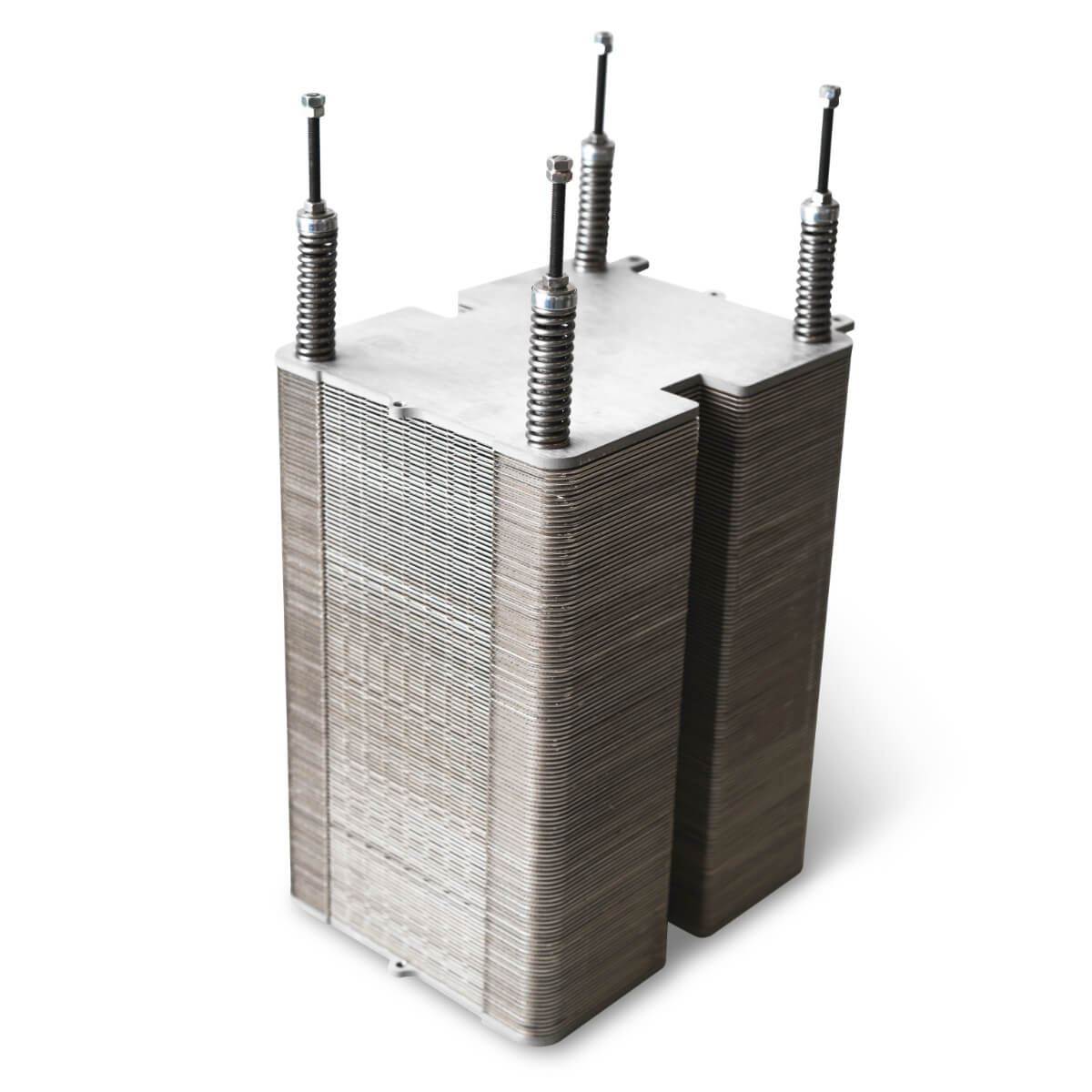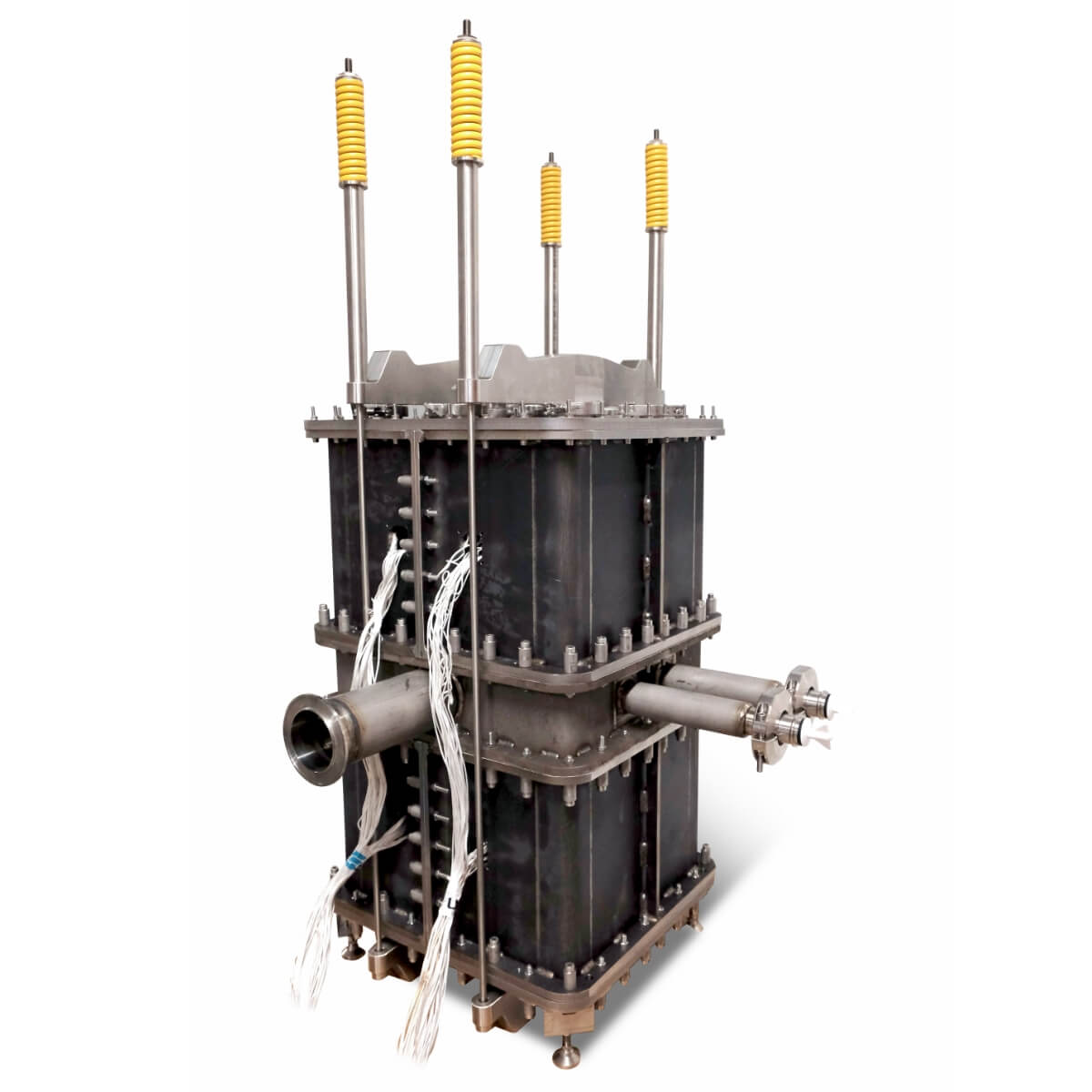This is a very important project for Elcogen. We developed the rSOC fuel cells that sit at the heart of the system that was used to demonstrate how this technology can be used as a power storing solution for renewable energy.
Reversible Solid Oxide Cell (rSOC) technology is able to operate either in electrolysis mode (SOEC) to store excess electricity as hydrogen or in fuel cell mode (SOFC) to produce electricity and heat again.
The development was part of an EU funded project – REFLEX. The project comprised the development of a reversible SOFC/SOEC system, which was integrated into a “Smart Energy Hub” coupled with batteries to solar and mini-hydro renewable sources to provide both electricity and heat to a nearby technology park outside Turin in Italy.
REFLEX (www.reflex-energy.eu) started on 1 January 2018 with a duration of 36 months and was funded by FCH2 JU grant agreement number 779577.
The Challenge
Storing renewable energy
Solar PV (photovoltaic) and wind power will be the keys to meeting carbon emission goals. In some scenarios, up to 65% of EU power generation will come from solar PV and wind (Energy Agency in its 2016 report). But to deal with the intermittent nature of renewable power sources like wind and solar, there is an urgent need to develop energy storage systems.
rSOC could be the solution
Buildings and eco-districts are increasingly becoming energy producers, with growing amounts of renewables installed. Optimising the self-consumption of this locally produced energy becomes a priority issue for the energy transition in order to avoid putting strain on transmission and distribution networks. The ability to store this energy for later use, while being able to produce combined heat and power from the same system thanks to the rSOC technology, will ensure that electricity supply matches demand at all times. The REFLEX project will demonstrate, in-field, the high power-to-power round-trip efficiency of the technology (as compared to other H2 based solutions) and its flexibility and durability in dynamic operation (power transient and switching between electrolysis and fuel cell mode).
The Goal
To develop an upscaled system of 15 kW SOFC and 80 kW in electrolysis mode to produce 16 Nm3/h of hydrogen, with the same efficiencies as previously obtained at small scale: > 80% HHV in SOEC mode, > 55% LHV in SOFC mode with CH4 fuel supply.
Elcogen goals
To optimize cells , which are integrated into 3rd party stacks for operation at high fuel utilization (> 85%) in both SOEC and SOFC modes and at high current density (- 1.2 A/cm² in SOEC mode below 1.3 V at 700°C, 0.6 A/cm² above at 0.8V in SOFC mode) to minimize the number of cells and the size of the stack for a defined power in order to minimize the CAPEX
Reflex project
Reversibility of SOEC/SOFC is seen as a strong disruptive innovation, that can allow to dramatically reduce the CAPEX in a power-to-power chain, as only one asset is needed, instead of two in a standard power-to-power chain (electrolyser and fuel cell systems), which in addition operates 100% of the time, which maximise the return on investment.
Project Partners
The development of the reversible SOFC/SOEC system was divided between nine organisations from six EU countries. Each organisation had its own specific task.
Reversible solid oxide fuel cells development

Elcogen developed solid oxide cells (SOFC, SOEC) technology in cooperation with the CEA and DTU.
We were selected because we have developed the world’s most efficient solid oxide fuel cell (SOFC) technology, with the market’s highest electrochemical performance and lowest operating temperature. We design our SOFCs to be manufactured at scale and produced from low-cost raw materials.
For the REFLEX project, Elcogen optimised the reference SOFC cell in terms of microstructure, thickness of constituting layers and interfaces to achieve high power densities and long durability in flexible mode.
Reversible solid oxide stack development

CEA (French Alternative Energies and Atomic Energy Commission) is a Research and Technology Organization (RTO). It aims to produce, integrate and transfer science and technology to help resolve the main EU challenges: low carbon energies, defense and security, information and healthcare technologies. CEA has more than 16,000 employees, filing more than 500 patents / year.
For REFLEX, the CEA optimised the stack to integrate Elcogen optimised cells and to operate in reversible mode.
Power Electronics

GPTech is a pioneer company in the development of power electronic devices which uses the state of the art technology to provide new solutions to the Renewable Energy Sector. GPTech’s experience in grid integration has made the company one of the most important suppliers of power electronics devices all over the world with presence in Europe, America, Asia and Africa.
For REFLEX, GPTech and University of Seville were taking on the power electronics development adapted for rSOC systems.
Reversible system design and manufacturing
Sylfen developed a fully integrated energy-storage system based on r-SOC technology (reversible Solid-Oxide Cells).
For REFLEX, Sylfen designed, engineered, manufactured and installed on-site the demonstration rSOC based Smart Energy Hub.
System modelling
VTT Technical Research Centre of Finland is a non-profit government organisation. VTT is the largest public applied research facility in Northern Europe with a staff of 2,500.
For REFLEX, VTT supported the system design by modelling tasks.
System field testing
Environment Park located in Turin Italy is an innovation accelerator for 70 companies that aim to expand their market with eco-efficient solutions. Energy savings, waste disposal, clean energy, new materials and assistance with fund raising are the services offered by EnviPark to help companies and public administrations to revolutionise their modus operandi.
The REFLEX system is installed at the ENVIPARK headquarters, to provide electricity and heat and maximise auto-consumption of local renewable energy.
Techno-economical analysis
ENGIE is a French multinational utility company operating in the fields of electricity generation and distribution, natural gas, nuclear, renewable energy and Petroleum.
For REFLEX, ENGIE provided techno-economic and market assessments.
The results
Reversibility of SOEC/SOFC is seen as a strongly disruptive innovation, that can enable a dramatic reduction of CAPEX in a power-to-power chain, as only one asset is needed, instead of two in a standard power-to-power chain (an electrolyser and a fuel cell systems), which in addition operates 100% of the time, maximising the return on investment.
Currently we can state that Elcogen has developed solid oxide cells with reversable mode. Our cells can produce electricity from fuels like biogas, diesel, natural gas, ethanol, methanol, propane, wood gas and LPG (SOFC mode). And to store excess electricity by producing hydrogen (electrolysis, SOEC mode) within the same cells. The development of our reversible cells continues and discussions are underway on commercialisation of the rSOC technology following the successful conclusion of the REFLEX






